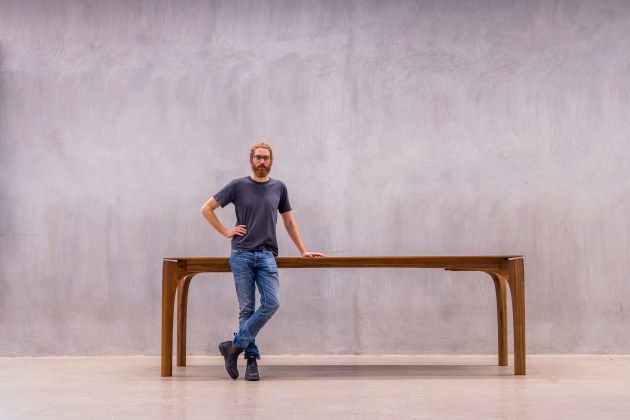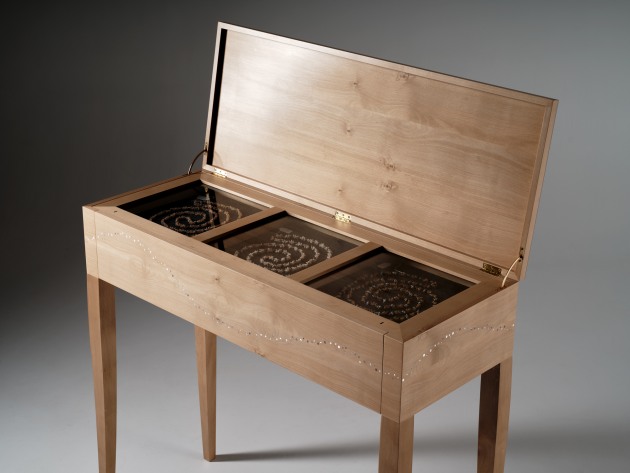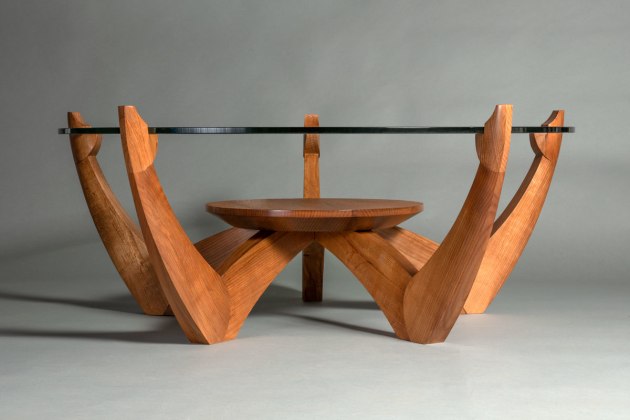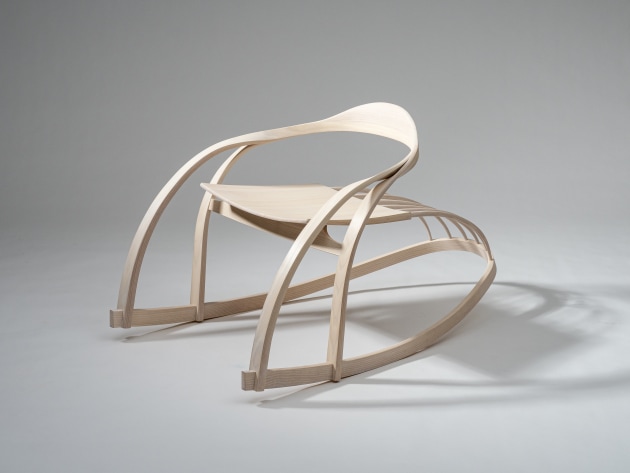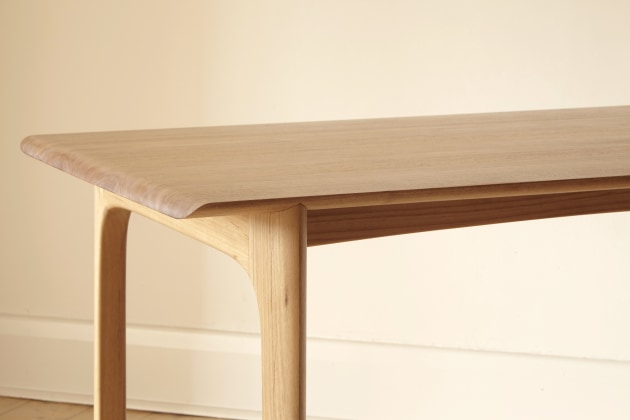Finding your voice: how to develop your style
OG Table, design and CNC templating by Adam Markowitz, made by Simeon Dux. Photo: Mitchell Ransome
Words: Adam Markowitz
One of the most fundamental questions that a designer maker must be able to answer in order to establish a sustainable business is: Why should people come to you? ‘I make heirloom quality fine furniture designed to last using fine timbers and traditional techniques.’ Okay. I can rattle off a list of two dozen other small-scale woodworkers around Australia within delivering distance of your client that offer the same services. What is the specific value that only you offer?
One aspect of answering that question is to find your voice in design. People come to you because only you make work like you. They can’t get it anywhere else. One of the most important things a small scale independent woodworker sells isn’t just the work we make, it’s ourselves, and our relationship to the work and to our clients.
Beyond the economic rationale – and perhaps far more importantly – establishing identity in your work is an essential part of making it your own. Once you start to establish your voice in your work, you can use that voice to say something, make beautiful, original things and contribute to the rich tapestry of creative endeavour.
Linda Fredheim, Shoreline, Tasmanian sassafras, greenlip abalone shell, PE felt, brass, aluminium and glass. ‘I aim to design and make furniture that has a quiet presence; objects that don’t demand attention, but invite interaction through exploration of details. I wanted (the piece) to be subservient to the contents, so I chose a very pared back-design, with minimal decoration. The colour of the sassafras is redolent of wet sand, which seemed appropriate given that the Palawa artists collect the tiny shells at low tide, and the undulating line of green lip abalone inlay is a reminder of the movement of the water.' Photo: Peter Whyte
What is a voice?
This probably needs a book rather than a paragraph to come close to defining. Your voice is a thread that runs through your work that ties it as a cohesive body of work to you. It’s the part that makes the work yours. I can pick out a Jimi Hendrix guitar solo or Louis Armstrong trumpet line straight away. It’s not just the instrument or the tune – it’s the way they play it. Your voice could be bold and flourishing like the sculptural work of Yuri Kobayashi or Seth Rolland. Or it could be quiet and considered like the work of Linda Fredheim, Rolf Barfoed or Aled Lewis. It can be through the use of particular timbers or a strong narrative connecting to place and country, such as in the work of Damien Wright or Ross Annels.
Decisions, decisions
While it is the most obvious, I think it can be misleading to think purely of the overall form of a piece when considering people’s voice in their work. Rather I think a voice is established through a network of decisions that are made throughout the realisation of the piece.
Makers will come to the same crossroads time and again when working. How does this bit connect to that bit? How does this edge terminate? What proportion should this part be relative to that part? It is how each of those decisions are made, and how those decisions are related to each other, that begins to define your voice – over time, a pattern of decision making starts to develop.
The first step in this process is realising you are in fact making a decision, and that every decision is a design decision. Work that I like the least is not necessarily through poor workmanship but rather through poor decision making, or no decision making, not even realising that a decision has been made!
Having rigour and consistency in decision making is a good way to begin to define your voice. When I was studying in Denmark they would point to a detail and ask: ‘Why is this the way it is?’...and if you couldn’t answer, it had to be deleted or reconsidered. This doesn’t mean that every decision has to be purely functionalist in nature, but that arbitrary decisions (or, non-decisions) should be avoided.
Aled Lewis, Aran desk, oak. ‘I try to design work that combines utility and integrity. I’m looking for an understated and timeless quality in my work, clean and uncomplicated. I rely on light and shade to accent some of the subtle detailing that I think is interesting – that could be the “voice” in my work, but I’d much rather it be a whisper.’ Photo: Mark Juliana
Your language
Consider the work of Brian Cush, who has a strong, highly legible and consistent design language, which I imagine stems from his design training as an architect. When I look at his work there are a number of patterns that define his decision making. In timber selection he only works with Australian species (I don’t share his rigour here!). There is a clear preference for expressing the structural logic (joinery). In almost every piece you will find an expression of the joint and in many cases these will be expressed as the central detail of the piece, often being sized or detailed beyond what they need to be for purely structural reasons.

Bryan Cush, Pinch Bench, reclaimed jarrah, Victorian ash, concrete core, brushed aluminium / brass strips. ‘‘In any form of visual art you have a split second to hook the viewer’s attention. However, this doesn’t mean our work must scream “look at me”. Instead, I opt to incorporate one key design idea into each piece to stick in people’s consciousness. This could be through the use of positive and negative space, unusual proportions, or three- dimensional forms influenced by architecture rather than furniture.’ Photo: Bryan Cush
Bryan likes strong lines and geometry – there is a detail of a repeated slat/ batten that implies a geometric plane but allowing a visual transparency that regularly appears in his work.
In his Pinch Bench this rhythm of battened elements is combined with the expression of the structural logic with the repeated lap joints. Damien Wright once described Bryan as ‘a furniture maker for people who like their whisky neat’ – the design language is clear, to the point and no bullshit. You can tell a Bryan Cush piece straight away.
Learning to speak
Finding your voice is something that needs to be worked on. It’s not something you can suddenly switch on, but it is something you can develop by actively taking charge, and owning and being intentional about the decisions you make at each point in the process. In time your voice will mature and may even change and evolve as you grow as a designer.
When we are learning and early in our careers, the obvious first step to learning how to navigate and take ownership of our decision making in design is to learn from those whose work we admire and how they have approached the decision making process.
The first serious piece of furniture I ever made was under my first mentor Hamish Hill, while I was studying at Melbourne University. Hamish’s work has a strong and distinct voice. He often looked at the stories embedded in things – for example his 2007 exhibition Secrets took pieces removed during refurbishments to the Melbourne Town Hall Organ as the starting point for pieces of furniture which were often whimsical, cheeky and nostalgic. The piece I made was a hall stand made from an old recycled door featuring a number of cheekily repurposed elements. It was very reminiscent of Hamish’s work, and even featured bits of the Melbourne Town Hall Organ!
I’ve since moved on in my work to try to find my own voice, although I have taken many of the lessons of studying under Hamish with me, and it forms a part of the tapestry that makes up my voice. Researching and studying other craftspeople you admire is a great way of learning and understanding why certain things work and why they don’t.
Seth Rolland, Kumo Coffee Table, local alder darkened with lime. ‘Generally, I approach one piece at a time. With hindsight, I can group pieces and see themes, but it would be a stretch to say I had a premeditated plan for my body of work. Certain themes have endured, like my interest in natural forms, movement, stance and personality of the piece, as well as an exploration of materials and stripping a design down to its essence.’ Photo: Myron Gauger
As you progress to establishing your own identity as a craftsperson you must, however, learn how to use your voice to make that work your own, and not simply replicate the work of others, particularly once you start selling work. This takes courage and belief in yourself. It also takes an acceptance that your work most likely just won’t be as good as those masters from the start. How could it be? You have just started on your journey and they have been at it for a lifetime! It’s okay if your first chair isn’t as good as a Hans Wegner! The important thing is that the work is your own.
Until you start making your own work, you can’t begin to develop or grow your voice. It is much better to make work that is identifiably yours even if it might not quite yet be up to the standard of those you admire. That will come in time as you hone your skills...
Speak for yourself
Be wary of falling into the trap of copying other people’s work to try to short circuit the process of finding your voice and get good looking work quicker. Selling copied designs or transplanted details cheapens your work and cheapens the craft. As I said earlier, what we sell is as much ourselves as the work.
Yuri Kobayashi, Breathe – i hear you –, ash, white tinted oil finish. Photo: Mark Juliana. ‘Whether I am channeling my inner chaos into an abstract sculptural form or a functional decorative object, the challenge is how to embed poetic qualities in my work. Fabricating in wood with my two hands is as essential as breathing. It is how I think, shape my life, and relate to the world. In the hope of sharing compassion, encouragement, and inspiration, I play my hand as best I can.’ Photo: Mark Juliana
Designs and details are distinctive identities that each craftsperson slowly develops over many years, and is what makes their work unique. When details are copied, this identity is effectively taken away from the original designer.
Copying does something beyond just taking another maker’s language – it tells the public that we are not our work – the work exists independently of the relationship to the maker. We’re instead just a means to an end – we aren’t artists or people but rather just another machine that is used to make furniture, where our creative voice and that connection to the work is irrelevant and not fundamental to what we do.
OG Table, design and CNC templating by Adam Markowitz, made by Simeon Dux. ‘This was a commission for a three metre long, bar-height dining table that had to fully disassemble to fit in a small elevator. Working with the ogee curve in elevation and sectional profile, several of the ideas are evolutions of ideas developed in my writing desk, as well as the floating details of my Fred Table (itself an evolution of midcentury precedents).’ Photo: Mitchell Ransome
It doesn’t matter who makes the thing as long as the thing is made. Your personal creative voice is what sets you apart. It is the act of designing, inseparable from the act of making, that is the unique thing about what you do, and we as craftspeople need to protect and nurture this idea or risk losing our relevance and value. If a prospective client approaches you with a picture of someone else’s work and says ‘can you make this?’, see it as an opportunity to start a conversation about your worth.
The line between inspiration and imitation can be difficult to navigate. There are trends and fashions in furniture making – five years ago all the timber was blonde, now darker timbers like walnut are in vogue. Scandinavian minimalism was everywhere a few years ago, now people are looking for richer textures and materials, while forms are drawing on geometric primitives in a semi post-modernist revival (grumble).
Adam Markowitz, Writing Desk, recycled blackbutt. ‘Here I’m exploring the idea of the ogee curve in section (that is, the sectional shape of the leg), and how this might intersect with the tabletop. I’m playing here with the syntax of the junction of elements – tabletop and leg, in this instance working with the idea of intersection. In the OG Table (see above) I am keeping the two separate and playing with the negative space between the elements. Getting this table to appear simple while accounting for seasonal movement proved very challenging, and there is a lot going on under the hood.’ Photo: Charlie White
Are people copying each other or being inspired by each other? I would suggest that you can still be inspired by someone’s work (some of the best inspiration for new work comes that way), and yet still create work that is clearly yours by ensuring your voice remains the defining feature of the work.
To the client that asks you to replicate a piece from a photo say, ‘I can’t copy that directly, but I can use that as a starting point to make something that is uniquely designed by me for you’. It is possible to work within a style but still retain a distinctive voice.
Find the place where people look at your work and smile – not because of the beauty of the piece alone, but because of the conversation they are having with you by listening to the voice in your work.
Adam Markowitz @markowitzdesign is a Melbourne-based architect and furniture designer maker. He was profiled in issue 98 and last wrote about the work of Jon Goulder for Wood Review magazine. Learn more at www.markowitzdesign.com.au



